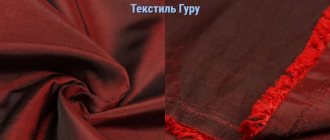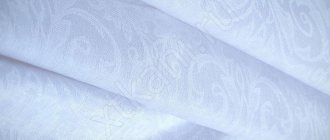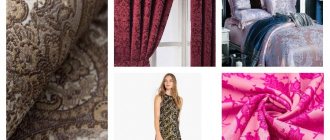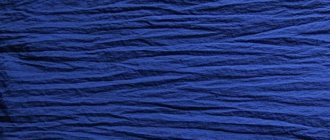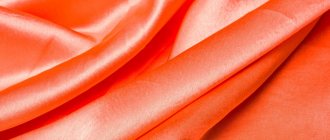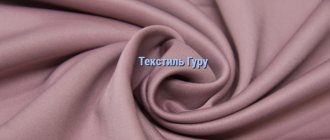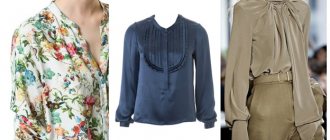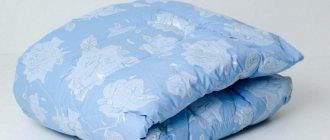Satin is a silk or mixed material with a front side with a pronounced shine. Translated from Arabic it sounds like “smooth”, which accurately describes the appearance of the fabric. Gives products sophistication and sophistication, bringing festiveness to interior design and endowing things created from it with attractiveness.
Description of material
The material has a dense surface with a glossy effect. The canvas can be smooth or patterned. Made from natural, synthetic and mixed threads.
The satin type of weaving was invented by Chinese craftsmen more than 2000 years ago. The production technology was not distributed, being kept secret, but later became known to Asian and European countries. Already in the 12th-13th centuries, atlas began to be exported to Italy. Acquaintance with the material in Rus' occurred in the 15th century. The lack of silk raw materials allowed the production of a limited amount of linen, which, due to its price, was available only to royalty, nobility and church ministers.
At the beginning of the 20th century, other components began to be included in the satin composition (acetate, viscose, nylon threads and polyesters). This made the fabric cheaper, making it accessible and in demand for sewing clothes and textile accessories. Fully synthetic matter is also found.
How is an atlas made?
The fabric is produced using a special type of weaving of threads, invented in China two thousand years ago. In this case, the warp threads overlap 5-7 weft threads, shifting in each subsequent row. The result is a satin fabric, shiny and smooth on one side, and matte and slightly rough to the touch on the other. There is also a double-sided satin, smooth on both sides.
One-sided material can be plain-dyed or patterned. In the first case, it has a monochromatic structure, and in the second they differ in the way the patterns are made:
Production Features
The fabric is made using two types of weave (satin or satin). The method consists of releasing the main weft threads onto the front part, through five or more warp threads. The material is endowed with a smooth and shiny effect on one side and matte on the other. The double-sided satin fabric is completely smooth due to the use of sets of warp fibers from two bundles.
The most expensive fabric is made from natural silk fibers. With the discovery of synthetic components, production has become widespread, so you can purchase satin freely, choosing any color scheme and texture.
Customer Reviews
Most of our clients agree on satin: its pleasant shine, smoothness and strength make this fabric truly competitive in the modern textile world. However, the problem of the high price of satin, even made from artificial fibers, is still relevant.
The catalog of the TISSURA Fabric House presents a wide selection of satin fabrics, both for dresses or blouses, and for suits or linings. Our consultants will be happy to help you calculate the required number of meters, select accessories, and answer all your questions, for example, about the possibility of purchasing in bulk.
Compound
The classic version of satin is made from natural silk. To be economical and give it various characteristics, natural or synthetic threads are used: cotton, polyester, viscose, nylon, acetate, elastane.
Fabric with the addition of mixed threads is resistant to color loss and shrinkage. But it does not bring such pleasant tactile sensations as natural satin, which is much more expensive than artificial satin. Modern technological techniques make it possible to create textiles based on synthetic raw materials, without silk fibers.
Characteristics of the atlas
Natural satin looks very presentable and elegant, but fabrics with the addition of other fibers also look no worse due to the special weave of the threads. This type of fabric has properties due to which it has not lost popularity for so many years:
- glossy, elegant shine;
- pleasant and smooth to the body;
- emphasizes the lines of the figure;
- drapes beautifully;
- dense and elastic;
- wide scope of application.
Such characteristics of fabrics allow them to be made from various types of clothing, jewelry, shoes, and used in interior design.
Classification
Satin fabric is classified by texture, method of dyeing and technique of applying patterns.
The texture of the fabric is:
- Smooth (has a uniform structure).
- Patterned (with relief designs).
By dyeing method:
- Maintenon. Plain textiles contain an embroidered pattern, similar to a print.
- Trianon. Wins with contrast. On a light base there is a pronounced darker pattern or vice versa.
- Pompadour. A pattern woven in gold stands out on a dark field.
According to the method of execution of patterns, the following types of atlas are distinguished:
- Embroidered (the design is done mechanically on top of a woven smooth fabric).
- Printed (finished textiles are dyed by a printer or roller).
- Embossed (the pattern is extruded with an engraved thermal roller).
- Jacquard (obtained by introducing a new weave onto the front part).
Varieties of patterns
The design of the atlas is not limited by strict rules; it can be either patterned or plain. Patterns can be applied in different ways:
- Direct printing method. The design is transferred to the finished fabric using special inks and a printing block. It has better detail, a wider range of colors and additional effects than silkscreen printing.
- Jacquard. Wrinkle-resistant fabric with a pattern made of complex weaving. The image on the front side is identical to the back side, but the lines are mirrored. Such satin is usually considered a curtain fabric.
- Embroidery. It can be done either manually or using modern machines or machines.
- Embossing. This artistic finishing of the fabric is quite extraordinary. It involves creating a three-dimensional image on a surface. This method requires the use of an engraved thermal roller.
Kinds
The composition affects the characteristics of satin fabric, its properties and appearance. Depending on the additives used, these are:
- taffeta - has a noble shimmer, combines simultaneous density and lightness;
- satin is a popular type, characterized by naturalness and a combination of silk and cotton;
- crepe - special twisting of the transverse threads results in a double-sided soft material with a slightly rough structure;
- Russian satin - the basis is raw silk using fine weaving of fibers;
- printed crash - bright and shiny fabric produced by pressing;
- duchess - endowed with special density and rigidity due to the tight weave of fibers;
- stretch – adding lycra adds elasticity and does not lead to the formation of wrinkles;
- dupont is the most shiny type of fabric, reminiscent of duchess in structure;
- antique - a textured look obtained by alternating sections (thin and thick) with threads as weft;
- guipure satin – new. The top layer is similar to guipure, but is not transparent due to the base of the fabric.
Curtain satin has a high degree of strength, therefore it is the heaviest in weight.
How to determine fabric density
Buyers can easily determine the density of the fabric using the information on the product label. Manufacturers always post up-to-date information that you will need to care for your items.
If there is no label or you are going to sew clothes or bedding yourself, use the chart of the density of popular fabrics.
- Silk. From 25 to 300 g/m².
| Density | Type of silk |
| 25-40 | Veil |
| 40-60 | Muslin |
| 110 | Taffeta |
| 196 | Crepe de Chine |
| 230-240 | Atlas |
| 300 | Silk velvet |
- Wool. From 140 to 690 g/m².
| Density | Type of coat |
| 140 | Dressing |
| 290-310 | Dress/costume |
| 530-550 | Costume; |
| 570 | Drape, coat |
| 670-690 | Blend/heavy coat |
- Cotton. From 55 to 150 g/m².
| Density | Type of cotton |
| 55-70 | Batiste |
| 70-150 | Poplin |
| 113-130 | Low density satin |
| 130-150 | High density satin |
- Linen. From 130 to 230 g/m².
| Density | Type of flax |
| 130-155 | For blouses and light dresses |
| 137-150 | For everyday dresses |
| 180-230 | For suits |
An important fact: density affects the strength of the canvas. A material consisting of the thinnest threads located closely will be stronger at break than one that consists of thick threads located at some distance.
Advantages and disadvantages
Satin is associated with touching cool water on a hot day, it is so pleasant and gentle to the touch. The material is distinguished by:
- good wear resistance, strength;
- maintaining quality even after repeated washings;
- high hygroscopicity (moisture absorption);
- resistance to deformation - with proper care, satin is not subject to shrinkage or stretching. Although it is noted that fabric with the addition of synthetics can stretch over time;
- hypoallergenic (does not irritate the skin);
- antistatic (not electrified).
Satin does not attract dust and dirt, wrinkles little and drapes well. But the material is “capricious”, shrinks under the influence of high temperatures, and therefore needs careful care. This can hardly be called a minus, just like the fact that curtain fabrics, due to their weight, are not easy to maintain and clean. The only drawback of the material is its flowability.
Clothes made from satin stand out from other outfits with their beauty. Attracts with tactile sensations and gives confidence to the owner.
Application
The variety of types of satin textiles makes it possible to widely use it in various fields:
- for the home: bedding sets, bedspreads, drapes, curtains. They decorate the room with the shimmer and shine of matter;
- formal wear for men and women: dresses and toilets for weddings and evening outings, stage and dance costumes;
- children's things: shirts, dresses and suits for matinees;
- home clothes: nightgowns, linen sets, pajamas, negligees;
- handbags, clutches, wallets, hats, pointe shoes for ballerinas and elegant ladies' shoes;
- bow ties, ties, umbrellas;
- brooches, earrings, bindings, ribbons;
- furniture upholstery (ottomans, sofas, armchairs and corners);
- lamps, floor lamps and sconces;
- decorative pillows and pillowcases;
- Kids toys;
- lining for coats, raincoats and fur products.
Designers use the luxury of satin to decorate furnishings, as decorative details in gift wrapping and in the manufacture of hair accessories. The material is combined with lace, chiffon, velvet and satin.
Care instructions
It is worth taking proper care of things made of satin fabric so that they do not lose their original shape and attractiveness. Care involves the following actions:
- read the label, which contains information on how to care for things and their composition;
- satin should be washed by hand in cool water with mild detergents;
- washing in a washing machine is allowed only if it is permitted by the manufacturer, and the “drying” function must be turned off;
- it is possible to soak in water with a liquid product for 10 minutes, followed by lightly squeezing out the foam;
- things made of satin cannot be twisted or compressed, as this will lead to the loss of their original shape;
- They must be rinsed thoroughly to completely get rid of any remaining foam. This can be done with the addition of vinegar or special products that preserve the brightness of the color;
- dry flat on a towel, away from heat and light;
- iron from the wrong side through gauze, without steam and at a low ironing temperature. In this case, it is necessary to exclude long-term fixation on one area of tissue (no more than 5 seconds);
- To extend the life of the product, take it to dry cleaning.
Atlas loves coolness, so do not store it at elevated temperatures. It is better to keep bedding sealed in containers that are reliably protected from heat and humidity.
Previously beloved material by representatives of royal dynasties and nobles, which contained historical secrets and understatement, successfully migrated to the 80s and became an attribute of the disco style. Cyclical fashion is returning, and with it the demand for fabric from the past is growing, because without a holiday, life is monotonous and monotonous, and satin gives a feeling of solemnity and joy.
